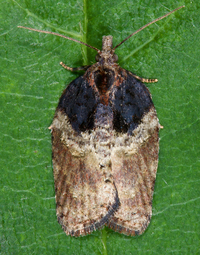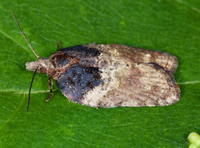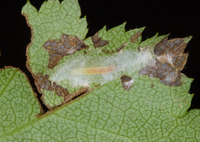Taxonomy
Superfamily:
Family: Subfamily: Tribe: P3 Number: MONA Number: MONA Synonym: Acleris hastiana
Comments: Based primarily on genetic differences, Gilligan et al. (2020) split populations in North America (now recognized as Acleris pulverosana ) from populations in Eurasia (Acleris hastiana ). They also note that populations of A. pulverosana in western North America show significant genetic differences from those in eastern North America, and that the two may represent different species. Here we treat all of the North American forms as A. pulverosana .
Identification
Adult Markings: Acleris pulverosana exhibits a wide range of phenotypes or morphs (see MPG for examples) and is best identified by genitalia. Once a genitalia-based library of morphs are built for local or regional populations, individuals often can be assigned correctly to this species using external patterning and coloration. Many of the morphs have forewings that are predominantly dark brown or dark reddish-brown, often with the veins lighter, and with various patterns of white overlay that include fine, longitudinal streaking, transverse bands, or white frosting. Other morphs have tan or grayish ground colors with various combinations of blackish to chestnut-colored longitudinal bands or streaks. Many of the morphs resemble those of A. flavivittana and dissection is often required to sort these out.
Wingspan: 20 mm (Forbes, 1923).Forewing Length: 7.5-11.0 mm (Powell and Opler, 2009).
Adult Structural Features: Gilligan and Epstein (2014) have illustrations of the male and female genitalia.
Adult ID Requirements: Identifiable only by close inspection of structural features or by DNA analysis.
Immatures and Development: The following life history account is mostly based on that of Gilligan and Epstein (2014), with the caveat that it was made before the Old World forms (Acleris hastiana sensu stricto) were split from the North American populations (now recognized as A. pulverosana ; Gilligan et al., 2020). As such, it is uncertain to what extent the following description reflects information on one or both of the currently recognized species.
Larvae ID Requirements: Identifiable only through rearing to adulthood.
Distribution in North Carolina
Distribution: Acleris pulverosana is found in both western and eastern North America, with the two groups geographically isolated from each other and genetically distinct to some degree (Gilligan et al., 2020). The western group ranges from southern California northward through the Pacific northwest and western Montana to British Columbia, Alberta and Saskatchewan. The eastern group is found in southern Canada from Manitoba eastward to Nova Scotia and Prince Edward Island, and in the U.S. from Maine westward to Minnesota and northeastern North Dakota, and southward to Illinois, Kentucky, and North Carolina. As of 2024, we have only a few records and all are from the Blue Ridge.County Map: Clicking on a county returns the records for the species in that county.
Flight Dates: Click on graph to enlarge
Immature Dates: Click on graph to enlarge
Flight Comments: The adults have been found during almost every month of the year in different areas of the range. Populations in eastern North America have been observed from March through November, with many populations likely having two generations per year. As of 2024, our very limited records are from mid-June and early-August.
Habitats and Life History
Habitats: Larval Host Plants: The larvae are polyphagous and feed mostly on trees and shrubs, with willows and other members of the Salicaceae appearing to be the most important hosts (Dyar 1904; Forbes 1923; Sheldon 1923; McDunnough 1934; MacKay 1962a; Powell 1964, 2006; Prentice 1966, Bradley et al. 1973; Ferguson 1975; De Benedictis et al. 1990; Brown et al., 2008; Powell and Opler, 2009). Most of the host records are from California and Canada, and include bog rosemary (Andromeda ), Paper Birch (Betula papyrifera ), Blueblossom (Ceanothus thrysiflorus ), huckleberry (Gaylussacia ), Sweet-gale (Myrica gale ), Nuttall's Scrub Oak (Quercus dumosa ), Balsam Poplar (Populus balsamifera ), Quaking Aspen (P. tremuloides ), Rhododendron , Sitka Willow (Salix sitchensis ), Weeping Willow (S. babylonica ), Coastal Willow (S. hookeriana ), Red Willow (S. laevigata ), Arroyo willow (S. lasiolepis ), Scouler's willow (S. scouleriana ), and Soft-leaved willow (S. sessilifolia ) and blueberries (Vaccinium spp. ). Prentice (1966) had 21 rearing records from Canada and all were for willows (Salix ). In North Carolina, we have one rearing record as of 2024 from a leaf fold on a hawthorn (Crataegus sp. ).
- View Observation Methods: The adults are attracted to lights. Wikipedia
Status in North Carolina
Natural Heritage Program Status: Natural Heritage Program Ranks: GNR [S1S3]State Protection: Has no legal protection, although permits are required to collect it on state parks and other public lands. Comments: This species appears to be rare in North Carolina, where it reaches the south limit of its range in the eastern U.S. As of 2024, we currently have only two site records for the state. More information is needed on its distribution, abundance, host use and preferred habitats before we can accurately assess the conservation status of this species within the state.

 »
»




 »
»


